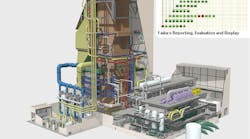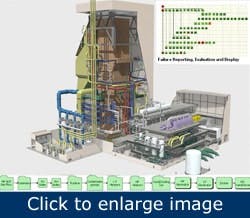Real-world users of asset management software have their priorities. They’ll implement enough of the software to meet their primary objectives and sometimes postpone or sidestep opportunities for broader benefits. Why? It may be a shortage of funding or project personnel, or they might just need time to enjoy the wealth of asset information now at their fingertips.
Process consultants and industry analysts, on the other hand, seek to extend the value of asset management software. They take a holistic view of its influence on equipment availability, plant performance and operating costs, and they strive to exploit its full potential. Although their paths vary, they and the end users ultimately share a common goal: to secure better asset health information and make timely, educated maintenance and management decisions.
Economics drive the asset management approach
The need for effective asset management is greater now than in the past. “It is not business as usual; the paradigm has changed. There is a lot of stress on equipment and budgets, and the workforce is aging.” says S. Rao Palakodeti, executive consulting engineer for asset optimization at Sigma Energy Solutions (www.sigenergy.com), a wholly owned subsidiary of Alstom (www.alstom.com). Companies need more information on how their equipment and systems behave so they can prioritize spending for greater ROI, explains Palakodeti. Without it, maintenance decisions are subjective.
Greenstar Recycling (www.greenstarrecycling.com) chose to implement asset management software for this reason. Recycling is a young industry that is heavily dependent on continuous processing equipment and industrial-strength trucks. The company entered the U.S. market in 2007 through acquisitions and is now recycling 2 million tons of material per year.
Asset management software helped Greenstar Recycling to cut its maintenance and repair costs by 40% over the first three years of its use in the Northampton, Pennsylvania, plant. (Source: Greenstar Recycling)
In 2008, Greenstar’s Northampton, Pennsylvania, material recovery facility (MRF) became the pilot site for its asset management software implementation. The software was subsequently rolled out to 14 MRFs throughout the United States and the Houston headquarters. It is used by operations and maintenance personnel and management alike, says Chris Morgan, plant manager at Greenstar Recycling.
Preventive maintenance schedules are set up for each asset in the software, and work orders are generated automatically. Maintenance and repair histories are used to track costs and troubleshoot problems. “We could see which conveyors and belting were not getting enough life, so we switched from two-ply to three-ply belts for a few hundred dollars,” says Morgan. “The extra cost was worth it; it added to our uptime and required less labor.”
The software helped Greenstar to cut its maintenance and repair costs by 40% over the first three years of its use in Northampton. “This was achieved with the management of preventive maintenance and the development of predictive maintenance through the analysis of the software’s various reporting functions,” says Morgan. “Proper maintenance and repair increased uptime, providing a safer, more efficient workplace.”
Ralph Rio, research director at ARC Advisory Group (www.arcweb.com), encourages reducing maintenance costs with a predictive approach. “Compared to preventive maintenance, which is largely time-based, predictive maintenance assures maintenance occurs when needed and significantly reduces the amount of maintenance performed,” he says.
For instance, while mechanical equipment wears out, most electronic and electromechanical equipment have purely random failure rates. “Research shows that a little more than 90% of these failures are random in nature,” says Rio. “This means scheduling preventive maintenance based on time is not as effective as it once was when most equipment was mechanical in nature.”
Historical view supports predictive decisions
New asset management tools and processes are available to increase availability with limited funds, producing smarter, objective, statistical analyses from which to project future asset health and make better spending decisions.
The most popular predictive maintenance mechanism is currently the historian because it is considerably less expensive than condition monitoring systems, says ARC’s Rio. Companies are monitoring asset and process readings, using the data to decide when maintenance is required, and alerting the planner to create a work order. “Most companies already have a historian with existing information. Any investment in programming and configuration time is small compared to acquiring an independent condition monitoring system.”
Past data from a historian allows you to project into the future. “It is a dynamic look using statistical analysis rather than a static look at failing equipment,” says Sigma’s Palakodeti. “Online performance monitoring allows proactive problem solving when it is directly integrated with a historian. Applying data models to the historian allows you to analyze past history and, through simulations, predict how equipment will perform in the future.”
Most historians log data obtained from sensors attached to a distributed control system (DCS) or programmable logic controllers (PLCs). With this data, the historian can perform calculations and, according to Rio, generate real-time alerts based on programmed thresholds. For example, heat exchanger maintenance traditionally involved time-based inspection and maintenance; if it looked clogged, you cleaned it. Now, with pressure sensors on both sides, the historian can measure the change in pressure and when it surpasses a calculated threshold, it’s time for inspection and cleaning.
Greenstar doesn’t use a historian or condition-based maintenance system. PLCs run most of its plants, but there is currently no integration between the control network and the asset management software. Instead, Greenstar focuses on which equipment causes most of the problems and whether the failures are repeatable in order to make predictive maintenance decisions.
“We essentially achieve condition-based maintenance through our asset management software,” says Greenstar’s Morgan. “Asset histories are used to monitor trends, and, as a result of the trends, our maintenance becomes more predictive. This helped us to increase our uptime in the plant.”
Benefit extension
Asset histories support decision-making in other applications, as well. For example, an increasing number of industrial organizations are recognizing the value of energy management and its role in asset management. “Modern asset management systems are good for enterprise-wide visibility and reporting when they are tied into the plant historian and the various energy management point solutions located throughout the plants,” says ARC’s Rio.
Past data from a historian allows you to forecast equipment health by using statistical analysis rather than a static look at failing equipment. (Source: Sigma Energy Solutions)
He gives motors — the biggest electrical energy users in the plant — as an example. “If you have visibility into all 10 hp motors across the plant and track the amount of electricity they consume based on load, you can take action on those that are least efficient,” explains Rio. “Energy flows through the asset, and the asset management software knows the equipment ID, its location, and work history. The software can automatically generate an alert and create a work order to upgrade or replace the motor.”
Sigma Energy Solutions has started using different electrical transient analysis programs to track the total load and distribution in plants where there are overload conditions. Asset management software aids in providing this information promptly to the planners. “With this software, we can see where electrical transients will be and whether a system can handle the load when new equipment is added,” says Sigma’s Palakodeti.
Emissions management is another opportunity for asset management software. Utilities and manufacturers are under pressure to minimize fugitive greenhouse gas emissions. Asset management software supports this goal by receiving emissions data and triggering work requests to repair or replace faulty equipment.
Field service has been the laggard in adopting asset management systems but the movement to cloud computing is changing that. In the past year, there has been fairly high growth among field-oriented asset management solutions in the cloud, explains Rio. “Cloud and field service is a good combination,” he says. “Rather than updating work orders from an office computer, technicians can enter the data while still on-site.”
Rio believes a missed opportunity in asset health is inventory management. “If there’s an outage and a needed part is out of stock, the downtime is unnecessarily extended if the part is actually in inventory and you don’t know it,” he says. This condition, caused by part number duplication, also contributes to excess inventory. “One end user who eliminated part number duplication found more than 100 stocking locations for one part across five plants,” says Rio.
Another missed opportunity is the optimization of inventory levels. One power-generation company that reexamined its min/max levels and usage was able to reduce inventory by a third, explains Rio.
When setting up stocking levels for bills of material in the asset management software, Palakodeti recommends leveraging the intelligence from historian or condition monitoring systems, rather than making subjective inventory decisions. The systems reveal which equipment, components, and parts are critical, allowing you to forecast inventory requirements based on how the equipment is likely to behave.
Although parts inventory can be controlled completely within Greenstar’s asset management software, the capability is not yet implemented. “When we acquired these plants a few years ago, there was no central-parts location or software. We built crude spreadsheets and tagged inventory and established min/max thresholds, so we have the foundation data and could easily make it electronic,” says Greenstar’s Morgan. “We do see value in pulling parts in the software. It’s just a matter of time and resources.”
Better information — better business decisions
A clear understanding of asset health and history not only supports plant floor decisions, but its influence is felt in the executive suite. Planners, engineers, and asset owners gain insight into the status and risks of specific equipment; plant directors glean awareness of which units and equipment are the highest priorities; and executives assess the entire system across all sites when determining which investments make the best business sense.
“Utility CFOs and CIOs include asset data in Public Service Commission rate cases to illustrate where the proposed funds will be spent and to justify how the investment will improve customer service,” says Sigma’s Palakodeti. “In addition, the COO and CFO recognize that asset capital and maintenance costs influence shareholder value.”
Excess asset inventory is also of concern to executives. “Too much inventory on the balance sheets is at the expense of cash, but, in this economy, most companies would prefer to have more cash,” explains ARC’s Rio. Excessive inventory impacts the ratios that Wall Street uses to valuate the company, which in turn influences the stock price. “Maintenance managers who invest in inventory rationalization are likely to become very good friends of the C-suite, especially the CFO,” adds Rio.
Repair/replace decisions come down to what makes the most business sense considering the equipment’s maintenance and cost history. “Currently our software is showing that we’ll likely spend almost 30% more in maintenance costs this year to repair two old forklift trucks than the other four trucks we operate at this plant. Although we still need to calculate depreciation, most likely we’ll buy two new forklifts rather than continuing to repair the old,” says Greenstar’s Morgan.
Outside help
Asset-intensive organizations are often constrained in their ability to roll out cost-saving initiatives. Many are operating especially lean with reduced headcounts, and they may be unaware of the existence of tools and technology that streamline processes or how to use them. Utilities in particular are more inclined to concentrate on firefighting while outsourcing asset management to outside agencies, explains Sigma’s Palakodeti.
[pullquote]Third parties fill the gaps where internal resources or expertise are lacking. For instance, historian calculations can get quite complicated, with virtual scenarios created using mathematical models, explains ARC’s Rio. Some plants with process engineering capacities develop historian calculations internally. Others use consultants or systems integrators.
Consultants performing specialty tasks like modeling and statistical analysis for predictive maintenance can set up the initiative and hand over an automated process rather than becoming a permanent fixture at the plant. “Once the modeling and statistical assessments are completed, with a little training, the utility can perform what-if scenarios with the touch of a button,” says Palakodeti.
For inventory rationalization, Rio recommends bringing in specialists once every few years rather than using internal personnel on a part-time basis for this task. Third parties likewise make sense for some IT services. Greenstar’s IT department does not manage the company’s asset management software. The software is Internet-based and the vendor handles all upgrades, patches, and server maintenance.
Knowledge is power
The best asset management decisions are based on current asset health and historical knowledge. Whether or not the asset management software is integrated with historians or supplementary solutions, companies can make proactive use of the systems they have to make educated business decisions.
Greenstar Recycling proved this with its asset management solution. “If you use the reporting tools that the asset management software has to offer, you can accomplish a lot of the same objectives as condition-based maintenance,” says Greenstar’s Morgan. “We trust the data in the asset management software. It plays a valuable role in the efficient operation of our plants and contributes to Greenstar’s success in preserving the world’s natural resources.”
When the time is right, companies can consider extending the software’s benefits. “There are newer, better ways of doing things that will make jobs easier, but the industry needs to get over its fear of the unknown and keep an open mind,” says Sigma’s Palakodeti.
Also, take a look at the new solutions in the market. “If your asset management software is 10 years old, or you last looked at mobility three or four years ago and didn’t see a good fit, the time to reassess is now,” says ARC’s Rio. “There have been huge changes in both.”


